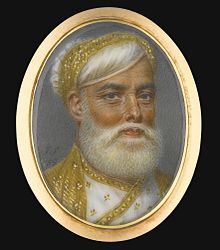Muhammed Ali Khan Wallajah
| Muhammad Ali Khan Walla Jah | |
|---|---|
|
Nawab of the Carnatic Amir ul-Hind Walla Jah Umdat ul-Mulk Asaf ud-Daula |
|

Muhammad Ali Khan Walla Jah
|
|
| Reign | 1749–1795 |
| Predecessor | Anwaruddin Khan |
| Successor | Umdat ul-Umara |
| Issue | |
|
Full name
Muhammad 'Ali Anwar ud-din Khan
|
|
| Father | Anwaruddin Khan |
| Born | 7 July 1717 Delhi, Mughal India (now India) |
| Died | 13 October 1795 (aged 78) Madras, India |
| Buried | outside the gate of the Gunbad of Shah Chand Mastan, Trichinopoly |
| Religion | Islam |
| Military career | |
| Allegiance |
|
| Service/branch | Nawab of the Carnatic |
| Rank | Subedar |
| Battles/wars | Mughal-Maratha Wars, Carnatic Wars, Anglo-Mysore Wars |
Muhammad Ali Khan Wallajah, or Muhammad Ali Khan Walla Jah (7 July 1717 – 13 October 1795), was the Nawab of Arcot in India and an ally of the British East India Company. Muhammad Ali Khan Wallajah was born to Anwaruddin Muhammed Khan, by his second wife, Fakhr un-nisa Begum Sahiba, was a niece of Sayyid Ali Khan Safavi ul-Mosawi of Persia, sometime Naib suba of Trichonopoly, on 7 July 1717 at Delhi. Muhammed Ali Khan Wallajah the Nawab of Arcot often referred to himself as the Subedar of the Carnatic in his letters and correspondence with the then Mughal Emperor Shah Alam II.
His official name was Amir ul Hind, Walla Jah, 'Umdat ul-Mulk, Asaf ud-Daula, Nawab Muhammad 'Ali Anwar ud-din Khan Bahadur, Zafar Jang, Sipah-Salar, Sahib us-Saif wal-qalam Mudabbir-i-Umur-i-'Alam Farzand-i-'Aziz-az Jan, Biradarbi Jan-barabar [Nawab Jannat Aramgah], Subadar of the Carnatic.
It was said of Muhammad Ali Khan Wallajah, that he could be courteous, immensely hospitable, always emulating English customs and manners, such as taking breakfast and tea, and sitting on chairs rather than cushions. He held two investitures, bestowing the KB upon Sir John Lindsay and Sir Hector Munro, in 1771 and 1779, respectively.
He granted the titles of Siraj ud-Daula, Anwar ud-din Khan Bahadur, and Dilawar Jang, together with the Subadarship of the Carnatic Payeen Ghaut and a mensab of 5,000 zat and 5,000 sowar, the Mahi Maratib, Naubat, etc. by Imperial firman on 5 April 1750.
...
Wikipedia
